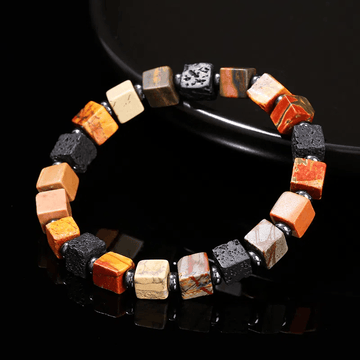Judgment and adjustment of the tightness when wearing a stone bracelet
First, the criteria for judging tightness
Comfort benchmark
Ideal state: After wearing it, the bracelet can be turned easily without sliding on the wrist.
Taboos: If it is too tight, it may impede blood circulation (such as numbness in the fingers), or if it is too loose, it may slip (such as the bracelet slipping to the forearm when raising the hand).
Quantitative reference
The difference between the inner diameter of the bracelet and the wrist circumference:
Daily wear: The inner diameter should be 1.0 to 1.5cm larger than the wrist circumference (for example, if the wrist circumference is 18cm, choose a bracelet with an inner diameter of 19 to 19.5cm).
Sports wear: The inner diameter is 1.5 to 2.0cm larger than the wrist circumference (for example, more movement space is required when running or rock climbing).
Dynamic testing
Finger test method: After wearing, if one finger (about 0.5cm) can be inserted, it is moderate; if two fingers (about 1cm) can be inserted, it is slightly loose.
Action test: After making a fist, bending the elbow, raising the hand and other actions, there was no obvious change in the position of the bracelet.
Second, common issues and risks related to tightness and looseness
Too tight
Symptoms: Skin marks, numbness in fingers, and difficulty in removal.
Risk: Long-term wearing may lead to blocked blood circulation, skin damage, and even deformation of the bracelet due to external force squeezing.
Too loose
Manifestations: The bracelet slips off, rotates and collides with the wrist.
Risk: The risk of loss increases. Stone and metal accessories may be damaged due to collision, resulting in a poor wearing experience.
Imbalance when worn on one side
Manifestations: The bracelet is tilted and rubs against the clothes.
Risk: Increases the risk of bracelet damage and appears visually uncoordinated.
Third, the method for adjusting tightness
Open-type bracelet
Adjustment method: Adjust the tightness by the size of the opening (for example, for a silver opening bracelet, the opening Angle can be slightly adjusted).
Tool assistance: Use a pair of pointed-nose pliers to gently clamp both sides of the opening, adjusting by 0.1cm each time to avoid deformation caused by excessive force.
Tip: Place a soft cloth (such as a glasses cloth) at the opening to prevent scratches on the metal surface.
Closed bracelet
Chain type: The length can be increased by extending the chain links (for example, the titanium steel chain type can be increased or decreased by 1 to 2cm).
Knot style: Adjust the position of the knot or replace it with a thicker/thinner string (such as a hand-woven diamond knot bracelet).
Special design: If the bracelet has a telescopic spring, you can try stretching or compressing the spring to adjust the tightness (such as some silver jewelry bracelets).
Elastic rope style
Adjustment method: Adjust the tightness by increasing or decreasing the number of knots.
Note: Elastic ropes are prone to aging. It is recommended to check them every six months. Replace them in time if any looseness is found.
Fourth, handling of special circumstances
The influence of stone weight
Heavy stones (such as tiger's eye and lapis lazuli) : The tightness should be appropriately increased to prevent the bracelet from sliding down due to gravity.
Lightweight stones (such as obsidian, agate) : Can be selected according to the standard deviation value without additional adjustment.
Seasonal variation
In summer: The wrist may swell due to sweating. It is recommended to choose a slightly looser wearing method.
In winter: The wrist circumference shrinks, so you can appropriately tighten the bracelet.
Cultural and religious factors
Buddhists: When wearing a Tianzhu bracelet, it is necessary to ensure that the tightness is moderate to show piety. If it is too tight, it may be regarded as disrespectful to the faith.
Islamic culture: When wearing lapis lazuli bracelets, traditionally, they tend to be slightly tighter to symbolize reverence for the deities.
Fifth, verification after adjustment
Static verification: After wearing for 10 minutes, check if there are any marks on the wrist or if the skin turns white.
Dynamic verification: Perform actions such as making a fist and extending your arms to ensure the stability of the bracelet's position.
Long-term verification: Wear continuously for 24 hours and observe whether there is any discomfort or damage due to uncomfortable tightness.
Sixth, maintenance suggestions
Regular inspection: Check the tightness of the bracelet every month to see if it changes due to the aging of the rope or metal fatigue.
Cleaning and maintenance: After wearing, wipe with a soft cloth to prevent sweat stains from corroding the metal parts.
Professional adjustment: If the bracelet has a complex structure (such as gemstone inlays), it is recommended to send it to a professional jewelry store for adjustment.
Summary: The tightness of a stone bracelet should be comprehensively judged based on the characteristics of the stone, the wearing scenario, and personal habits. After adjustment, it needs to be verified through multiple dimensions to ensure comfort and safety.







